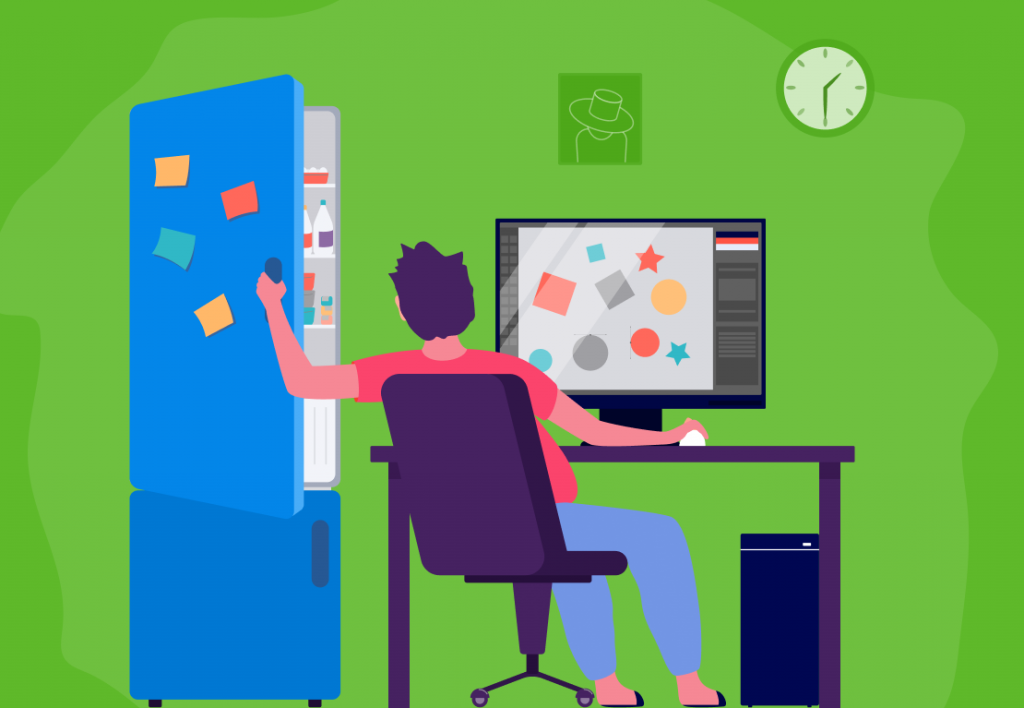Is remote work good for you? Here’s what research says.

Thanks to technological advances like cloud computing and instant messaging, more workers are working remotely than ever before. In fact, research by FlexJobs and Global Workplace Analytics indicates that the number of employees telecommuting in the US grew by 159% from 2005 to 2017.
Of course, given the emergence of the COVID-19 crisis, this number has only continued to increase. According to a Gallup survey, the percentage of people working from home in the US doubled—from 31% to 63%—in under a month as a result of the coronavirus.
Want to get the most out of your time?
Try DeskTime for free!
Try free for 14 days · No credit card required.
By signing up, you agree to our terms and privacy policy.

Remote work, and the preference for it, is nothing new. Even before the onset of COVID-19, remote work has been gaining momentum. A growing number of workers prioritize the availability of remote work in their job searches, citing flexibility and work-life balance as major draws.
However, as appealing as working remotely may be, it also poses new health risks. As more companies and employees shift toward telecommuting, it’s important to understand the health ramifications of this novel work lifestyle.
What are the health effects of working remotely?

Without the physical commute required of a traditional job, many remote work advocates are quick to point out its health benefits in freeing employees’ schedules. For instance, remote employees can sleep, exercise, or partake in relaxing activities in lieu of a long daily commute. Furthermore, advocates argue that workers can better avoid exposure to germs and infectious diseases as well as pollution and potential accidents on the road.
While there’s certainly truth to these benefits, remote work situations do not manifest uniformly. Circumstances vary among workers—for instance, the size of one’s home workspace, the presence of other household members (like children), and other conditions that may impinge upon productivity. As a result, remote work presents new challenges that adversely affect mental and physical health in ways that a traditional work environment does not.
Here’s what research on the subject says:
- According to a 2017 report from Eurofound, 41% of remote workers experienced high stress compared to just 25% of office workers. This may be because “leaving work at the office” is virtually impossible when the office is your home, making work-life balance tenuous at best.
- In a study of 1,100 workers, employees who worked from home were more likely to experience social isolation from their peers. Moreover, 21% of remote employees viewed loneliness as the biggest challenge of telecommuting—an exceptionally bigger concern for anyone living alone or working in a role that involves little interaction with others.
- Though remote work can enhance productivity, it also sets the stage for more burnout. In a 2019 survey by Digital Ocean, 82% of remote tech workers in the US reported experiencing burnout. Besides mental fatigue and exhaustion, burnout can over time, weaken one’s immune system and cause chest pain and shortness of breath.
- Lastly, remote work may encourage a more sedentary lifestyle and unhealthy eating habits. These adverse physical effects aren’t solely because of remote work; sedentary work in general, whether in an office or at home, is connected to a greater risk of cardiovascular disease, diabetes, and obesity. However, telecommuting can exacerbate this as employees may exit their homes less frequently. Moreover, telecommuters may snack more frequently given the proximity of their kitchens.
9 best practices for creating a healthy remote work lifestyle

Though work-from-home circumstances vary, it’s possible to mitigate or remove altogether the negative impact of telecommuting through conscious effort and habit. To create a healthy work environment and routine, keep these nine best practices in mind.
1. Establish a distinct workspace.
A distinct workspace sets a boundary between work and personal activities. If you have a room you can claim as a home office, fantastic. A separate office clearly demonstrates to you and any other members of your household when you are or aren’t working.
The luxury of having a dedicated office isn’t possible for everyone, though. If you don’t have a spare room:
- Look for a distraction-free space conducive to working.
- Pick a space away from the television, your bed, the refrigerator, and whatever else might draw you away from work.
- Communicate to all members of the household that you do not want to be bothered when you’re in this space.
2. Besides creating a physical workspace, create a separate virtual one.
Creating a separate workspace doesn’t only apply to your physical surroundings; it also matters in a virtual context.
If you can—for instance, if your employer provides them—use a different computer and phone for work activities. This way, you can shut off dedicated work devices at the end of your workday. Work-related push notifications disrupt your personal life, and in the long run, contribute to worse mental health and burnout.

If you can’t maintain separate work and personal electronic devices, try creating boundaries within your devices. Apps like SelfControl and Freedom limit access to distracting websites and apps so you can block yourself from visiting Facebook during work hours. Similarly, to preserve your personal time, turn off work notifications during non-work hours.
3. Optimize your workspace for ergonomics.
When your desk, computer, keyboard, or chair are set up improperly, you risk neck and back injuries, eye problems, headaches, carpal tunnel syndrome, among other health issues.
To minimize the physical toll of working remotely, create an ergonomic workstation:
- Adjust your seat so that your monitor is eye-level and close enough that you don’t need to strain your eyes or lean your head forward.
- Keep a set of eyedrops nearby. In an office setting, cubicle neighbors and in-person meetings help break up extended screen time. But with more Zoom meetings and Slack messages to tend to, you’re likely focusing on your computer more constantly—which can lead to computer vision syndrome.
- Position your monitor away from windows. Glare and reflections on your screen can also tire your eyes.
Note that a healthy desk setup is impossible when you’re using a laptop’s keyboard and monitor. Laptops require you to raise your hands, crane your neck, or both to simultaneously type and view the screen. This doesn’t mean you need to buy a whole new desktop computer if you own a laptop, though.
Instead, find a low-cost keyboard you can connect to your laptop. Then use a laptop riser or a household object (like a shoebox or stack of books) to elevate your laptop so that the upper-middle portion of the screen sits at eye level.
4. Leverage technology.
Technology enables employees to work remotely—but that’s not the only extent to which you can leverage it for your telecommuting needs. Besides setting up a separate, ergonomic workspace, consider incorporating the following apps and equipment into your work lifestyle:
- f.lux – The artificial blue light emitted from your device screens takes a toll on the quality of your sleep, circadian rhythm, and mood, especially with prolonged exposure. If screen time is affecting your rest and well-being, download f.lux. This handy app adapts your computer screen to the time of the day, meaning less blue light in the later hours.
- Interval Timer – Without coworkers nosing in to say hi in person, it’s easy to get engrossed in work and lose track of time. Consider using an interval timer as a reminder to take regular breaks. Many apps and sites with this function exist, but you can also simply set an alarm on your phone for regular breaks throughout the day.
- Blue light blocking glasses – Reports on whether this eyewear truly works are mixed, but it’s worth a shot if you experience dry eyes or blurry vision from excessive screen time.
- Noise-canceling headphones – If outside noise is affecting your productivity—and thereby making you work longer hours—invest in a pair of these headphones to drown out distracting sounds.

5. Practice “out of sight, out of mind” with known distractions.
You might feel more productive in a traditional work environment not just because it’s a dedicated workspace, but because it lacks the distractions in your home. If that’s the case, try taking an “out of sight, out of mind” approach. In other words, remove any distractions from your physical view.
For example:
- Place your phone on airplane mode or in another room—or do both—to shut down the urge to scroll through your newsfeed. The same goes for tablets that aren’t essential to your work.
- Clear away unnecessary clutter from your workstation. Now that you’re working from home, sentimental tokens and trinkets are more distraction than decoration. If your space is bogged down by work-related items, collect them in a folder and place it off to the side.
- To stave off work boredom, you may feel driven to eat even when you’re not hungry. If so, keep junk food in closed cupboards and cabinets rather than out in clear view. (To go a step further and avoid possible issues like weight gain, replace these snacks with healthier alternatives.)
Tempted by other distractions in your home? Whether it’s the television remote, a book, or something else, move it out of sight. While you can’t completely erase its existence, you can at least remove visual reminders.

Want to prevent overworking?
Prioritize and set healthy boundaries!
6. Build in house chores and errands as breaks.
Telecommuting can be jarring for those unaccustomed to working from home, especially with chores and home projects beckoning from every corner. However, you can use these house tasks to better manage your work time, such as by planning chores as breaks.
For instance, folding your clothes on laundry day makes for a healthy and productive break by encouraging you to rest your eyes and move away from your screen. The same goes for getting up to vacuum, do the dishes, or take out the trash. These activities break up the monotony of sitting and remaining fixed on your laptop.

Some chores can even be repurposed as timers for completing a certain task or project—for example, a complete washer or dryer cycle, the amount of time it takes for your frozen pizza to bake, and so on. If a deadline makes you more productive, aim to finish work according to these home-based timers.
7. If possible, mix up your work hours.
The flexibility to adjust your work hours ultimately depends on the nature of your role and company. However, if possible, doing so can do mean huge benefits for your productivity—not just health.
So long as your employer grants permission, flexible work hours mean you can base your schedule around your lifestyle, rather than the other way around. For instance:
- Work when you’re at your most productive, whether that’s in the early morning or late night.
- If you’re a parent, align your schedule with your children’s class hours or other activities. This way, you won’t have to stress about dividing your attention between competing priorities.
- Schedule a nap, workout, or downtime when you need it. You’ll work more efficiently when you’re well-rested.
8. Dress professionally.
Staying comfortable while working from home is fine, but sitting around in your pajamas all day isn’t. Substantial research supports the notion that clothing influences mindset and behavior, even to the point of improving abstract thinking and negotiation skills.
So if you struggle with staying motivated or easily fall prey to distractions while working from home, dress professionally; it can set the tone for more success.
But beyond enhancing your productivity, wearing more formal attire can also set clear boundaries for when it’s time to sign off. Change into and out of designated “office clothes” at the start and end of your workday to reinforce these boundaries and get a better sense of work-life balance.
You wouldn’t wear dress pants while getting ready for bed, after all. Let your natural change in outfits stop you from constantly checking your work inbox even when it’s time to rest.

9. Look beyond business—connect with your colleagues.
Finally, since feeling isolated is one of the major risks of remote work, put in effort to create meaningful relationships with your colleagues. Research consistently indicates that strong work relationships correlate with greater job satisfaction and work performance.
Though you may be separated by states, countries, or even continents, physical distance doesn’t mean developing a sense of work camaraderie is impossible. To connect with your colleagues:
- Hold video conference meetings instead of relying solely on emails, chat messages, and phone calls. Despite how effective other methods may be, video calls tend to feel more personal. Without verbal and emotional cues, misinterpreted emails and messages can give rise to conflict and feelings of alienation.
- Practice sincere niceties in your communication to show interest in your coworkers’ lives. For instance, ask colleagues about their weekend plans, and use more specific greetings like “Good morning” and “Good evening.”
- Celebrate occasions like colleagues’ birthdays, holidays, or major business events, e.g., the closing of a big sale. Give praise to coworkers’ accomplishments; if you’re a manager, thank subordinates for their work from time to time.
- If a lax work culture or atmosphere exists, use GIFs or emojis in your team communications. These simple graphics add a pop of personality and feel more human than text alone.
Conclusion
As remote work continues to become more prevalent around the world, it’s important to understand its impact on individual health and well-being. Telecommuting does not manifest uniformly, after all. Some employees adapt with few concerns; others may suffer mental or physical consequences, or both. Regardless, when workers understand how to create a healthy and productive remote work lifestyle, they experience enhanced work performance and a stronger work-life balance.
About the Author
Joyce Chou is a Content Marketing Strategist at Compose.ly, a content platform that matches businesses with seasoned freelance writers. Apart from managing and writing for Compose.ly’s blog, Joyce also contributes to other publications about digital marketing, personal finance, and business and ecommerce.
Did you find this article useful? Give it a clap!
Psst! You can clap more than once if you really loved it 🙂